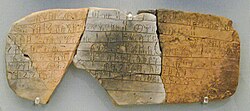Linear B
From Wikipedia, the free encyclopedia
This article is about the ancient syllabary. For the JavaScript engine, see linear b (script engine).
Not to be confused with Linear Pottery culture.
| Linear B | |
|---|---|
 | |
| Type | |
| Languages | Mycenaean Greek |
Time period
| Late Bronze Age |
| Status | Extinct |
Parent systems
|
Linear A
|
Sister systems
| Cypro-Minoan syllabary |
| Direction | Left-to-right |
| ISO 15924 | Linb, 401 |
Unicode alias
| Linear B |
| |
Linear B is a syllabic script that was used for writing Mycenaean Greek, the earliest attested form of Greek. The script predates the Greek alphabet by several centuries. The oldest Mycenaean writing dates to about 1450 BC.[1] It is descended from the older Linear A, an undeciphered earlier script used for writing the Minoan language, as is the later Cypriot syllabary, which also recorded Greek. Linear B, found mainly in the palace archives at Knossos, Cydonia,[2] Pylos, Thebes and Mycenae,[
No comments:
Post a Comment